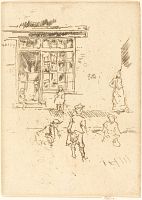Etchings Institutions search term: wunderlich
Marbles | ||
| Number: | 270 | |
| Date: | 1886/1887 | |
| Medium: | etching and drypoint | |
| Size: | 133 x 98 mm | |
| Signed: | butterfly at upper right | |
| Inscribed: | no | |
| Set/Publication: | no | |
| No. of States: | 3 | |
| Known impressions: | 5 | |
| Catalogues: | K.284; M.280 | |
| Impressions taken from this plate (5) | ||
KEYWORD
children, game, people, shop-front, street.
TITLE
It has always been known by the same title, as in the following examples:
'Marbles' (1886/1888, Whistler). 1
'Marbles' (1889, Whistler). 2
'Marbles' (1898, Wunderlich's). 3
'Marbles' (1902, Edward Guthrie Kennedy (1849-1932)). 4
'Marbles' (1886/1888, Whistler). 1
'Marbles' (1889, Whistler). 2
'Marbles' (1898, Wunderlich's). 3
'Marbles' (1902, Edward Guthrie Kennedy (1849-1932)). 4
DESCRIPTION
Three boys, two kneeling and one standing between them, play marbles on the cobbled road in front of a small shop. The standing one in the centre is holding a bag, which is probably full of marbles. A toddler is seated on the top step of the shop-door facing right, and a man is partly visible within, bending over to right, partly concealed by the window. Bottles, boxes and other small items are stacked on shelves in the many-paned window to right of the open door, and in a narrow window running above both the door and window. A child in a short skirt stands in front of the shop-window, and a woman stands at far right, at the street corner. Lettering - possibly 'BATEY' or 'BACEY' - appears on a panel to left of the door.
There are faint outlines of an earlier version of the standing woman at right and traces of the head, shoulders and back of a woman, upside-down, at lower left.
SITE
Probably the East End or Chelsea, in London, England.
DISCUSSION
Children playing in the streets or on door-steps figure frequently in Whistler's etchings. This, however, is the only one to show a specific game. There are many versions of the traditional children's game, played with small coloured clay balls, which could be hand-made (originally made in Nurembourg from marble, and much later, mass-produced in coloured glass).
In one basic version, called 'Taw', a circle is drawn on the ground and one or two marbles are put into the circle by each player. Then each player in turn shoots at them with another marble and keeps any marbles they knock out of the circle. Other versions could be played against a wall or along a gutter.
The best marbles were kept for shooting rather than as targets. WEP project-director had a splendid brown clay one that won many glass marbles!

